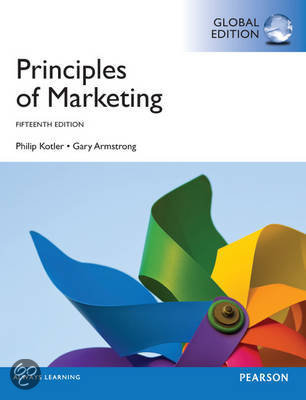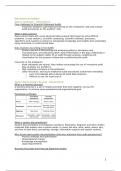Marketing & Sales
Week 1
Chapter 1: Creating costumer value and engagement
Marketing = engaging customers and managing profitable customer relationships.
In this 5-step plan, the following happens:
1. Needs, wants, demands: needs means a basic human need, like a roof over your
head. Wants is what humans would like, such as a big mansion. Demands is where
the money steps in and makes a person settle for an apartment.
2. Market offerings: a combination of products, services, information or experiences
offered to fulfil a certain need of want. A side effect here is marketing myopia, when a
seller pays more attention to the specific product, than to the benefits and
experiences produced by this product. With smart marketing you look beyond this
and will want to solve the actual problem.
3. Customer value and satisfaction: sellers don’t want to set the bar too high, because
customers will be disappointed. They also don’t want to set it too low, because it
would not attract enough buyers
4. Exchanges and relationships: the seller expects something in return. This would
make an exchange with the costumer. This creates costumer relationships.
5. Markets: the set of all actual and potential buyers of a product or service. Today, it
also means customer-managed relationships.
Marketing management = the art and science of choosing target markets and building
profitable relationships with them. With a winning strategy you ask yourself “What costumers
will we serve, and how to serve them best?”.
Marketing managment orientations:
- The production concept: the idea that costumers will favour products that are
available and highly affordable. Therefore, the organisation should focus on
improving production and distribution efficiency.
- The product concept: costumors will favour the products that offer the most quality,
therefore the organisation should devode its energy to making continiuous product
improvements.
Focusing on quility and efficient manufacturing. Examples: oil, raw materials, banking.
- The selling concept: costumers will not buy enough of the firm’s products unless it
undertakes a large-scale selling and promotion effort. Ussually, with things people
don’t think of buying, such as life-insurance. Agressive promoting techniques. More
supply than demand.
- The marketing concept: this focuses on the costumers needs and wants. It adapts to
a changing market. Intergrated approach to marketing activities. This increases
buying power and competition. Ex. L’Oréal or IKEA.
, - The societal marketing concept: the idea that a company’s marketing decisions
should consider costumer’s wants, the company’s requirements, costumers’ long-run
interests and society’s long-run interests. Because of this, many companies now
preach ‘shared value’. Ex. The Body Shop or Tony’s Chocolonely.
Customer relationship management = the overall process of building and maintaining
profitable customer relationships by delivering superior customer value and satisfaction.
Customers-perceived value = the costumer’s evaluation of the difference between all the
benefits and costs of a marketing offer relative to those competing offers.
Customer satisfaction = the extent to which a product’s perceived performers matches a
buyer’s expectation.
There are multiple ways to have a customer relationship as a brand;
- Basic relationships (Haagen-Dazs trough marketing with every costumer)
- Full partnerships (Haagen-Dazs with large retailers such as Tesco)
- Frequency marketing programmes (KLM’s Flying Blue membership)
- Club marketing programmes (BMW Car Club)
Customer-engagement marketing = making the brand a meaningful part of consumer’s
conversations and lives by fostering direct and continuous customer involvement in shaping
brand conversations, experiences and community. Ex. Posting on social media, funny videos
- Costumer-generated marketing = brand exchanges created by consumers
themselves, both invited and uninvited, by which consumers are playing an
increasing role in shaping their own brand experiences and those of other
consumers. Ex. Customer-generated commercials, youtube.
Partner relationship management = working closely with partners in other departments and
outside the company to jointly bring greater value to customers.
Creating value for targeted costumers: mass marketing, one offer. OR target marketing,
everything possible, creating your own shoe design.
, The outcomes of creating costumer value:
- Creating customer loyalty and retention: when a customer is satisfied, they are loyal.
Which means they will buy more. And so is created the customer lifetime value
- Growing share of costumer: the portion they get of the costumer’s purchasing in its
product categories will be bigger. This can be created by giving more variety to the
costumer.
- Building costumer equity: the total combined customer lifetime values of all the
company’s customers. It’s important to build relationships with the right costumers
The changing marketing landscape:
- The digital age
- Economic changing environment
- Rapid globalisation
- Experience marketing
- Not-for-profit marketing
Week 2
Chapter 7: customer-driven marketing strategy: creating value for target customers.
After creating costumer value comes market segmentation, market targeting and
differentiation and positioning.
Market segmentation = involves dividing large, heterogeneous markets into smaller
segments that can be reached more efficiently with products and services that match their
unique needs.
- Geographic. Nations, regions, countries, cities etc.
- Demographic. Age, gender, family size, occupation, education, race etc.
- Psychographic. Social class, personality, lifestyle.
- Behavioural. Knowledge, attitudes, uses, responses to a product.
Market targeting = evaluating the various segments identified during the segmentation
process on three factors and deciding how many and which segments it can serve best.
1. Segment size and growth.
2. Segment structural attractiveness. Competition, substitute products, bargaining
power, power of suppliers, threat new entrants.
3. Company objectives and resources. Fit or not, skills & resources.
Week 1
Chapter 1: Creating costumer value and engagement
Marketing = engaging customers and managing profitable customer relationships.
In this 5-step plan, the following happens:
1. Needs, wants, demands: needs means a basic human need, like a roof over your
head. Wants is what humans would like, such as a big mansion. Demands is where
the money steps in and makes a person settle for an apartment.
2. Market offerings: a combination of products, services, information or experiences
offered to fulfil a certain need of want. A side effect here is marketing myopia, when a
seller pays more attention to the specific product, than to the benefits and
experiences produced by this product. With smart marketing you look beyond this
and will want to solve the actual problem.
3. Customer value and satisfaction: sellers don’t want to set the bar too high, because
customers will be disappointed. They also don’t want to set it too low, because it
would not attract enough buyers
4. Exchanges and relationships: the seller expects something in return. This would
make an exchange with the costumer. This creates costumer relationships.
5. Markets: the set of all actual and potential buyers of a product or service. Today, it
also means customer-managed relationships.
Marketing management = the art and science of choosing target markets and building
profitable relationships with them. With a winning strategy you ask yourself “What costumers
will we serve, and how to serve them best?”.
Marketing managment orientations:
- The production concept: the idea that costumers will favour products that are
available and highly affordable. Therefore, the organisation should focus on
improving production and distribution efficiency.
- The product concept: costumors will favour the products that offer the most quality,
therefore the organisation should devode its energy to making continiuous product
improvements.
Focusing on quility and efficient manufacturing. Examples: oil, raw materials, banking.
- The selling concept: costumers will not buy enough of the firm’s products unless it
undertakes a large-scale selling and promotion effort. Ussually, with things people
don’t think of buying, such as life-insurance. Agressive promoting techniques. More
supply than demand.
- The marketing concept: this focuses on the costumers needs and wants. It adapts to
a changing market. Intergrated approach to marketing activities. This increases
buying power and competition. Ex. L’Oréal or IKEA.
, - The societal marketing concept: the idea that a company’s marketing decisions
should consider costumer’s wants, the company’s requirements, costumers’ long-run
interests and society’s long-run interests. Because of this, many companies now
preach ‘shared value’. Ex. The Body Shop or Tony’s Chocolonely.
Customer relationship management = the overall process of building and maintaining
profitable customer relationships by delivering superior customer value and satisfaction.
Customers-perceived value = the costumer’s evaluation of the difference between all the
benefits and costs of a marketing offer relative to those competing offers.
Customer satisfaction = the extent to which a product’s perceived performers matches a
buyer’s expectation.
There are multiple ways to have a customer relationship as a brand;
- Basic relationships (Haagen-Dazs trough marketing with every costumer)
- Full partnerships (Haagen-Dazs with large retailers such as Tesco)
- Frequency marketing programmes (KLM’s Flying Blue membership)
- Club marketing programmes (BMW Car Club)
Customer-engagement marketing = making the brand a meaningful part of consumer’s
conversations and lives by fostering direct and continuous customer involvement in shaping
brand conversations, experiences and community. Ex. Posting on social media, funny videos
- Costumer-generated marketing = brand exchanges created by consumers
themselves, both invited and uninvited, by which consumers are playing an
increasing role in shaping their own brand experiences and those of other
consumers. Ex. Customer-generated commercials, youtube.
Partner relationship management = working closely with partners in other departments and
outside the company to jointly bring greater value to customers.
Creating value for targeted costumers: mass marketing, one offer. OR target marketing,
everything possible, creating your own shoe design.
, The outcomes of creating costumer value:
- Creating customer loyalty and retention: when a customer is satisfied, they are loyal.
Which means they will buy more. And so is created the customer lifetime value
- Growing share of costumer: the portion they get of the costumer’s purchasing in its
product categories will be bigger. This can be created by giving more variety to the
costumer.
- Building costumer equity: the total combined customer lifetime values of all the
company’s customers. It’s important to build relationships with the right costumers
The changing marketing landscape:
- The digital age
- Economic changing environment
- Rapid globalisation
- Experience marketing
- Not-for-profit marketing
Week 2
Chapter 7: customer-driven marketing strategy: creating value for target customers.
After creating costumer value comes market segmentation, market targeting and
differentiation and positioning.
Market segmentation = involves dividing large, heterogeneous markets into smaller
segments that can be reached more efficiently with products and services that match their
unique needs.
- Geographic. Nations, regions, countries, cities etc.
- Demographic. Age, gender, family size, occupation, education, race etc.
- Psychographic. Social class, personality, lifestyle.
- Behavioural. Knowledge, attitudes, uses, responses to a product.
Market targeting = evaluating the various segments identified during the segmentation
process on three factors and deciding how many and which segments it can serve best.
1. Segment size and growth.
2. Segment structural attractiveness. Competition, substitute products, bargaining
power, power of suppliers, threat new entrants.
3. Company objectives and resources. Fit or not, skills & resources.











